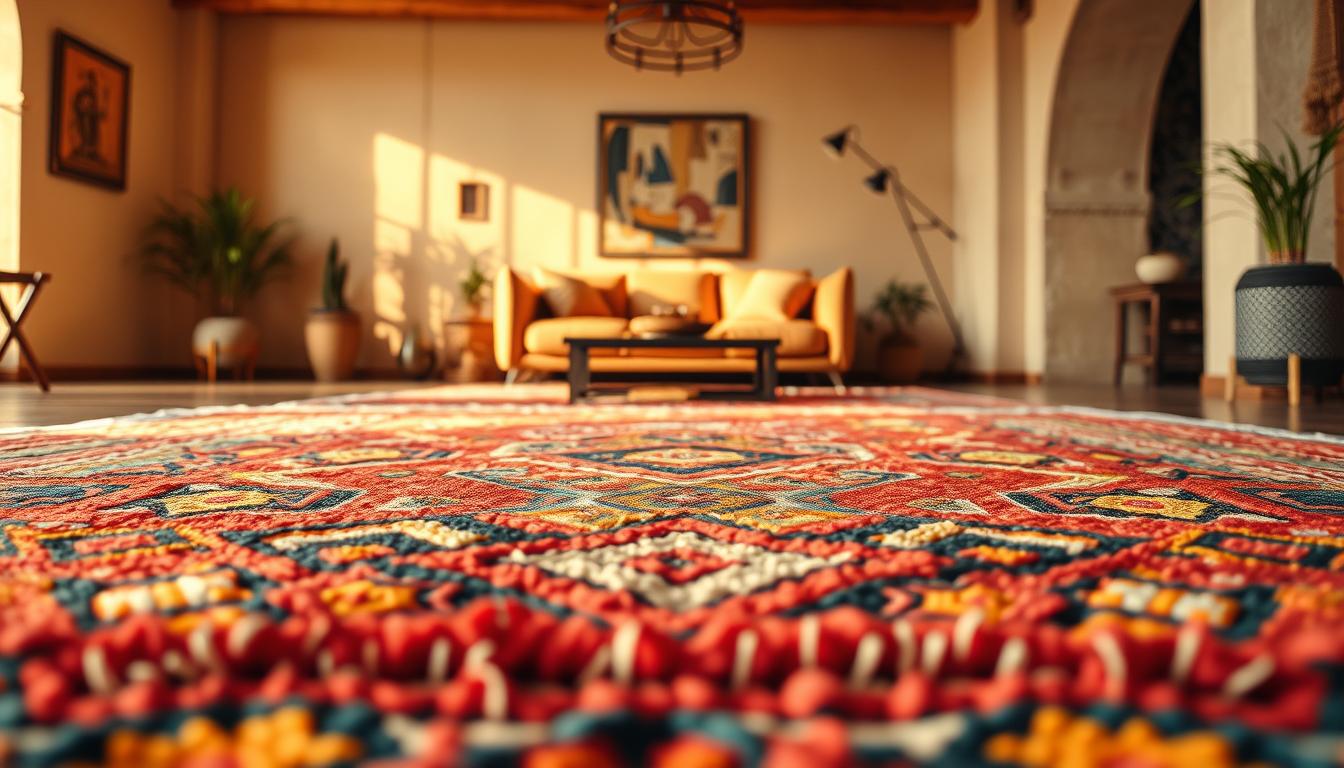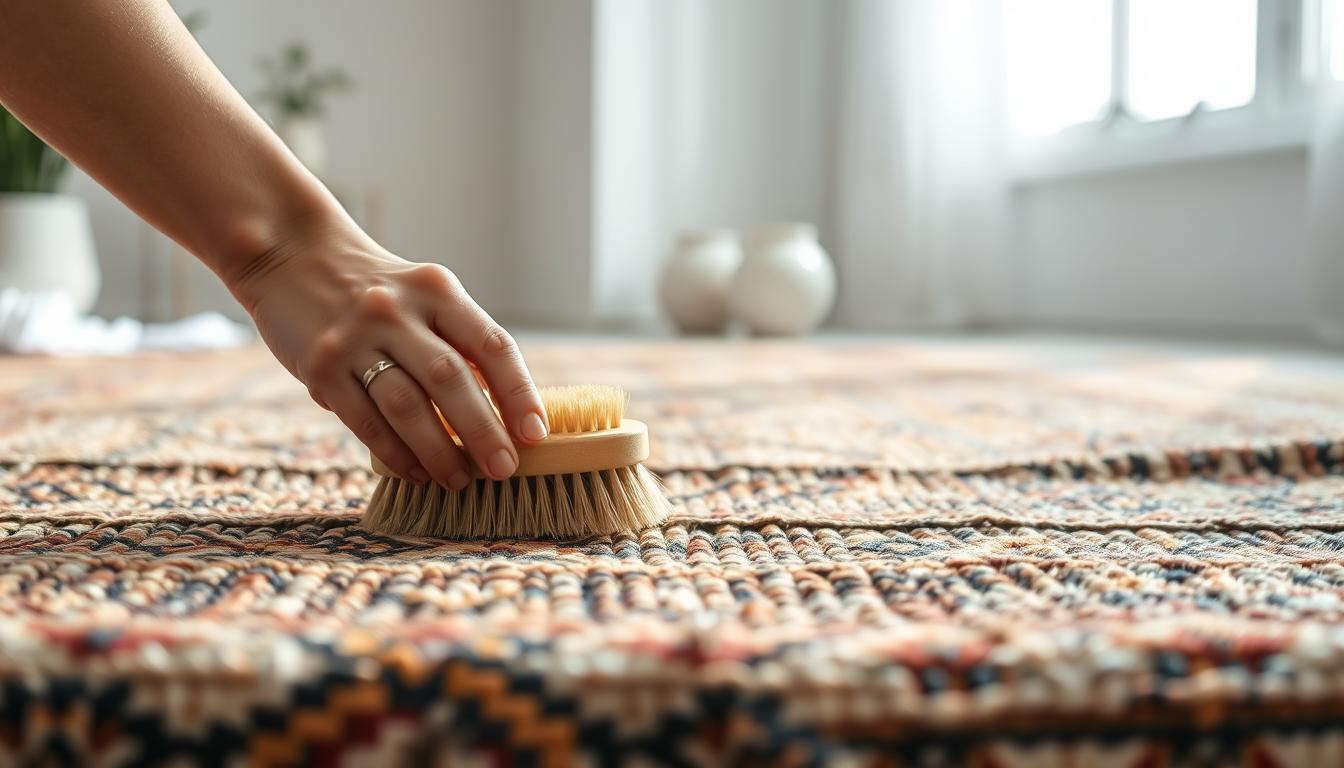
7 Living Room Ideas with a Moroccan Rug

Imagine walking into a room where every thread whispers tales of Berber tribes and desert caravans. How might artisan traditions from North Africa breathe new life into your modern home? This guide reveals how handwoven textiles become more than floor coverings – they’re heirlooms that bridge cultures while elevating your design narrative.
You’ll explore seven innovative approaches to integrate these versatile ultimate upgrade elements. From minimalist layouts craving texture to maximalist spaces needing balance, each concept demonstrates how to let patterns do the talking. Discover why interior designers increasingly turn to these pieces for their unmatched ability to unify color schemes and architectural features.
Beyond aesthetics, you’ll learn practical considerations. High-pile options create cozy nooks for family gatherings, while durable low-pile weaves withstand daily foot traffic without sacrificing visual impact. We’ll show how to position your centerpiece to highlight room proportions or disguise awkward layouts.
Key Takeaways
- Transform any area using heritage-rich textiles as foundational design anchors
- Select pile heights based on functional needs and aesthetic preferences
- Enhance existing color palettes through strategic pattern placement
- Protect floors while adding noise reduction benefits
- Blend contemporary furniture with traditional craftsmanship seamlessly
Introduction to Moroccan Rugs in Your Living Space
What if your floors could speak in geometric poetry? Moroccan rugs transform spaces into cultural dialogues, blending ancient symbolism with modern design needs. These textiles aren’t just accents – they’re bridges between eras.
Threads of Time and Tradition
Each knot carries centuries of Berber heritage. Indigenous female artisans use techniques unchanged for generations, weaving symbols that once mapped trade routes and tribal identities. Unlike mass-produced decor, these pieces preserve authentic cultural elements through natural dyes and hand-spun wool.
Patterns tell stories of survival and celebration. Zigzags mimic Atlas Mountain peaks, while diamond motifs represent protective eyes. This craftsmanship turns functional items into heirlooms that outlast trends.
Decor That Lives and Breathes
These textiles add warmth through texture and history. Earthy tones ground minimalist spaces, while bold geometries energize neutral palettes. Unlike synthetic alternatives, they develop richer patinas over time – each fade mark adding to their charm.
Your space gains layers of meaning. A rug’s heritage sparks conversations about global artistry. It becomes more than decor – a testament to human hands shaping beauty from raw materials.
Incorporating a living room with moroccan rug
Choosing the ideal centerpiece for your home involves both art and precision. Start by mapping your floor plan with painter’s tape – this simple trick reveals how different sizes interact with furniture layouts. Leave 12-18 inches between edges and walls to frame the space effectively without overwhelming it.

Selecting the Perfect Rug for Your Space
Measure twice, buy once. Focus on high-traffic zones when sizing up – a too-small rug makes seating areas feel disconnected. Earthy terracotta tones harmonize with neutral walls, while cobalt geometrics inject drama into monochrome schemes. Pro tip: Low-pile weaves withstand foot traffic better than plush options.
Creating a Warm and Inviting Ambiance
Texture tells half the story. Layer jute baskets or leather ottomans over your textile to amplify coziness. Warm ivory backgrounds soften angular furniture, whereas charcoal patterns ground airy, light-filled rooms. These pieces act as visual anchors, tying throw pillows and wall art into a unified narrative.
Consider pile height’s dual role – thicker fibers muffle echoes in open-concept areas, creating intimate zones. For sunlit spaces, lighter hues prevent the area from feeling heavy. Every choice should balance comfort and practicality, proving beauty needn’t sacrifice function.
Diverse Moroccan Rug Designs and Global Inspirations
What stories do geometric shapes whisper when they dance across your floor? Moroccan textiles offer a passport to global artistry, blending ancestral techniques with boundary-pushing creativity. Let’s decode their visual language.
Traditional Motifs and Artisan Craftsmanship
Berber artisans weave history into every knot. Azilal’s Diamond Flow design mirrors ancient tribal maps, while Earthen Motif pieces echo desert landscapes. These materials age like fine wine – sheep wool softens over decades, becoming family heirlooms.
Modern Interpretations and Fresh Styles
Today’s designers reimagine classic patterns for contemporary spaces. M'rirt’s Stormy Skies collection pairs faded indigos with crisp whites, perfect for ModernMinimalism enthusiasts. Synthetic blends offer stain resistance without sacrificing the handwoven aesthetic.
Unique Patterns and Vibrant Colors
From Tifelt kilims’ Hazy Blue gradients to Anzal’s Golden Moss textures, color becomes architecture. Bold geometries define zones in open layouts, while abstract compositions spark conversation. See how regional influences shape these masterpieces:
| Style | Key Feature | Material | Price Range |
|---|---|---|---|
| Azilal Traditional | Tribal diamond motifs | Handspun wool | $1,650-$2,258 |
| M'rirt Modern | Recessed line patterns | Wool-cotton blend | $2,100-$3,350 |
| Anzal Hand-Knot | Mottled color effects | Natural dyes | $1,782-$2,200 |
Your floor becomes a cultural crossroads. Whether choosing vintage-inspired wool or performance-driven synthetics, these pieces transform spaces into galleries of human ingenuity.
Styling Tips: From Vintage Vibes to Modern Chic
Your floors become a design canvas when styled with intention. Vintage Moroccan textiles like the Harika model offer timeless foundations, while modern interpretations balance heritage with clean lines. Whether aiming for eclectic energy or understated elegance, these pieces adapt to your vision.

Mixing Patterns and Complementary Decor
Let your rug set the rhythm for pattern play. A bold Beni Ourain design pairs well with solid-colored furniture, while subtle diamond motifs allow striped curtains to shine. Pro tip: Match one color from the textile’s palette to throw pillows for cohesion.
Scale matters. Large geometric patterns anchor spacious areas, while smaller motifs suit cozy nooks. For maximalist spaces, layer kilims over larger neutral rugs – this creates depth without visual chaos.
Layering Techniques for Visual Interest
Texture stacking transforms flat surfaces into dimensional stories. Place a woven jute mat beneath your centerpiece for earthy contrast, or add sheepskin throws to highlight plush wool piles. These combinations absorb sound in open layouts while adding tactile appeal.
Anchor seating groups by positioning front furniture legs on the textile’s edge. This technique defines zones in studio apartments and ties disparate decor elements into a unified aesthetic. Remember: your rug isn’t just decor – it’s the glue holding your design narrative together.
Caring for Your Authentic Moroccan Rug
Your heirloom textile deserves care that honors its journey from artisan hands to your home. Proper maintenance preserves both its physical beauty and the cultural narratives woven into every fiber. Let’s explore how to protect these masterpieces while respecting their origins.
Essential Cleaning and Maintenance Tips
Natural wool fibers thrive with gentle care. Vacuum weekly using a suction-only setting – rotating directions prevents pile distortion. For spills, blot immediately with a microfiber cloth and cold water. Avoid harsh chemicals that strip natural dyes, which artisans have perfected over centuries.
Seasonal deep cleaning? Use a step-by-step cleaning guide designed for handwoven materials. Sun-dry rugs briefly to prevent moisture damage, but limit exposure to fading.
Preserving the Rug's Cultural and Artistic Story
Rotate your piece every six months to ensure even wear. This simple act respects the balanced symmetry of tribal patterns. When storing, roll – never fold – to maintain structural integrity. Acid-free paper between layers protects dyes.
“A well-cared-for textile becomes a family chronicle,” notes a Marrakech weaver. Your stewardship ensures the stories behind diamond motifs and zigzag borders remain vivid for future generations. Each careful touch sustains a legacy older than modern interior design itself.
Conclusion
A Moroccan rug doesn’t just decorate—it narrates. Through its intricate Beni Ourain patterns and earthy textures, this textile becomes your home’s silent storyteller. Explore creative ways to blend eras through our guide on styling vintage finds in contemporary spaces.
These pieces offer dual gifts: visual warmth and cultural resonance. Their artisan heritage connects your space to generations of craftsmanship, while practical benefits like noise reduction and floor protection serve modern needs. Whether anchoring a minimalist layout or energizing eclectic decor, they adapt to your lifestyle.
Your choice becomes a bridge between worlds. Bold geometrics or subtle diamond motifs each carry stories of North African traditions. As you walk across these woven masterpieces, remember—you’re not just enhancing your home’s aesthetic. You’re preserving a legacy that transforms floors into living history.
FAQ
How do authentic Moroccan rugs differ from mass-produced options?
Authentic pieces are handwoven by skilled artisans using natural materials like wool. Each rug carries unique imperfections, cultural motifs, and centuries-old craftsmanship that factory-made versions can’t replicate.
Can these textiles work in modern minimalist spaces?
Absolutely! Opt for neutral tones, geometric patterns, or vintage Beni Ourain styles. Their texture and subtle designs add warmth without overwhelming clean-lined decor.
What’s the best way to maintain vibrant colors over time?
Rotate your rug periodically to avoid sun fading. Use gentle vacuuming and spot-clean spills immediately. Professional cleaning every 1-2 years preserves dyes and wool integrity.
Are certain patterns tied to specific regions or traditions?
Yes. For example, Boucherouite rugs use recycled fabrics symbolizing resourcefulness, while Azilal designs feature abstract symbols rooted in Berber storytelling. Each style reflects its community’s heritage.
How can I layer multiple rugs without clashing?
Pair a bold, patterned Moroccan piece with solid or textured neutrals. Keep scale in mind—anchor larger rugs beneath smaller ones, ensuring complementary color tones unite the look.
Do high-pile options like Beni Ourain shed excessively?
Initial shedding is normal with untreated wool. Regular gentle shaking helps. Shedding decreases significantly after 3-6 months as fibers settle, revealing the rug’s full plush character.









